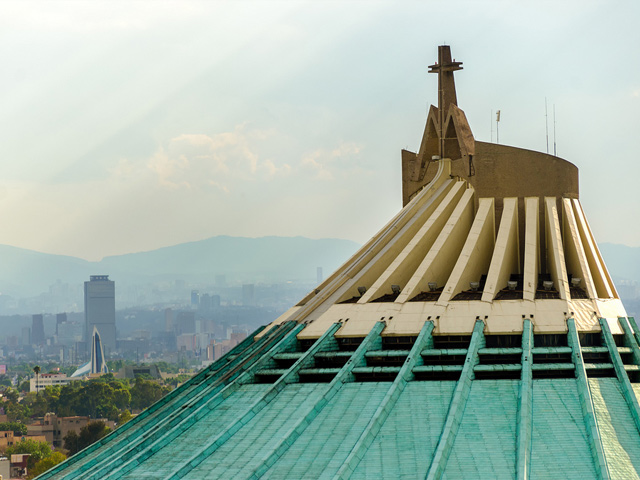
The Basilica de Nuestra Señora de Guadalupe in Mexico City. Photo © Lidia Lopez, licensed Creative Commons Attribution.
At any hour, on any day of the year, there is a crash of fireworks exploding over the Basilica de Nuestra Señora de Guadalupe in Northern Mexico City. Push through the crush of crowds at the gates to the shrine, and you’ll see hundreds of pilgrims climbing the well-worn stairs, many on their knees, and Catholic groups from across the country carrying banners, flowers, and other sentimental offerings. They have come here to pray to, pay homage to, or snap a photo of Mexico’s beloved “mother,” the Virgin of Guadalupe. The Basilica de Nuestra Señora de Guadalupe is the second most-visited Catholic shrine in the world, eclipsed only by the Vatican itself. On her feast day, December 12, more than six million pilgrims arrive at the shrine to pay homage to her image.According to 16th-century history, the Virgin de Guadalupe, dressed in robes of green, white, and red, and rimmed by angels and roses, first appeared to the Aztec nobleman Cuauhtaoctzin on December 9, 1521. Speaking in the native Nahuatl language, she instructed Cuauhtaoctzin — later to be baptized Juan Diego — to build a shrine in her honor. Church authorities initially ignored Juan Diego’s entreaties, but the virgin appeared again on December 12, instructing Juan Diego to carry a cloak to the local church. When Juan Diego unfurled the shroud before the bishop, it was filled with roses and miraculously imprinted with the likeness of the virgin herself.
The story spread across Mexico, inspiring thousands of native people to convert to Catholicism. The virgin’s dark skin, her Nahuatl tongue, and her appearance on the hill at Tepeyac (a place already sacred to the goddess Tonantzin in the native pantheon) helped this new figure appeal to the people. As instructed, her shrine was built at Tepeyac, and it was rebuilt several times over the following centuries. Today, there is an interesting assortment of old chapels along the hillside, most from the 1700s, while Juan Diego’s original cloak hangs behind the altar in the modern basilica, which was designed by renowned Mexican architect Pedro Ramírez Vázquez in the 1970s.
The shroud itself — which can viewed up close from a moving walkway that runs behind the altar — has numerous peculiarities. For instance, a variety of the colors in the image were not available pigments at that time, and their origin is still unknown. On top of that, these colors have not been muted despite their age, as well as the continual flash photography from pilgrims. Skeptics, however, have many reasons to doubt the validity of the virgin’s miraculous appearance, among them the existence of a very similar Virgin de Guadalupe from a remote corner of Spain where Hernán Cortés, among other Spanish conquistadors, once lived. Some historians even claim that there is no evidence Juan Diego himself existed.
No matter what the origins of the story, the power of this iconic image is hard to deny. During the War of Independence, father Miguel Hidalgo, a Catholic priest and the head of the Mexican army, used a banner depicting the virgin as the official flag for the Mexican army. Today, her image remains remarkably popular and distinctly Mexican, adorning thousands of T-shirts, key chains, posters, fabrics, and works of art. The Basilica de Nuestra Señora de Guadalupe is the second most-visited Catholic shrine in the world, eclipsed only by the Vatican itself. On her feast day, December 12, more than six million pilgrims arrive at the shrine to pay homage to her image.
Excerpted from the Second Edition of Moon Living Abroad in Mexico.